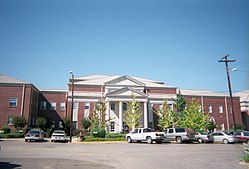Grove Hill, Alabama | |
|---|---|
Town | |
 Clarke County Courthouse in Grove Hill | |
 Location of Grove Hill in Clarke County, Alabama. | |
| Coordinates: 31°41′22″N87°45′42″W / 31.68944°N 87.76167°W [1] | |
| Country | United States |
| State | Alabama |
| County | Clarke |
| Government | |
| • Type | Mayor/Council |
| Area | |
• Total | 7.60 sq mi (19.68 km2) |
| • Land | 7.59 sq mi (19.66 km2) |
| • Water | 0.0077 sq mi (0.02 km2) |
| Elevation | 489 ft (149 m) |
| Population (2020) | |
• Total | 1,818 |
| • Density | 239.5/sq mi (92.48/km2) |
| Time zone | UTC-6 (Central (CST)) |
| • Summer (DST) | UTC-5 (CDT) |
| ZIP code | 36451 |
| Area code | 251 |
| FIPS code | 01-32080 |
| GNIS feature ID | 2406623 [1] |
| Website | https://townofgrovehillalabama.com/ |
Grove Hill is a town in Clarke County, Alabama, United States. At the 2020 census, the population was 1,818. It is the county seat of Clarke County and home of the Clarke County Museum.

